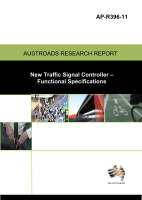Traffic Management

- Publication no: AP-R396-11
- ISBN: 978-1-921991-12-7
- Published: 5 December 2011
- PDF (free) Download
This report provides a traffic or logical architecture for the new controller. Austroads recognised the need to develop a new generation of traffic signal controllers, making use of modular, scalable design with an open architecture. Two key components in the architecture are the Signal Group Switch Module (SGSM) and the Control Module. The SGSM shall perform the function of signal group switching with high safety integrity on receiving commands from the Control Module. The Control Module shall have the flexibility to use a range of traffic control algorithms in the form of ‘plug-in’ applications. This project also provides, for the first time, a framework for the application of Australian Standards AS/IEC 61508 for the specification of the safety integrity levels (SIL) for key functional components in AATSC.
- 1. INTRODUCTION
- 1.1. Purpose
- 1.2. Scope
- 1.3. Organisation of the Document
- 2. OVERVIEW OF OPERATION AND ARCHITECTURE
- 2.1. Controller Perspective
- 2.2. Design Constraints
- 3. TRAFFIC FUNCTIONALITIES
- 3.1. Functional Specifications for Signal Group Switch Module
- 3.1.1. Functional Components of SGSM
- 3.1.2. System Requirement
- 3.1.3. Signal Group Switching
- 3.1.4. Gate Keeper
- 3.1.5. Interface to Control Module
- 3.1.6. Interface to Site Configuration Data
- 3.1.7. Interface to Master Relay
- 3.1.8. Interface to Flasher Unit
- 3.1.9. Interface to Site ID Encoder
- 3.1.10. File Logging
- 3.1.11. Time Base (Clock Function)
- 3.1.12. Hardware Watchdog Timer
- 3.1.13. Self-testing
- 3.2. Functional Specifications for Control Module
- 3.2.1. Functional Components of Control Module
- 3.2.2. System Requirements
- 3.2.3. Traffic Control Algorithms
- 3.2.4. Support Services
- 3.2.5. File Logging
- 3.2.6. Time Base (Clock Function)
- 3.2.7. Interface to Master Relay
- 3.2.8. Interface to Flasher Unit
- 3.2.9. Interface to Detectors
- 3.2.10. Interface to Site Configuration Data
- 3.2.11. Interface to SGSM
- 3.2.12. Interface to an ATCS
- 3.2.13. Interface to Controller Auxiliary Equipment
- 3.2.14. Interface to HMI
- 3.2.15. Interface to Other I/O Devices
- 3.3. Site Configuration Data
- 3.4. Communications Module
- 3.4.1. Communication with the ATCS
- 3.4.2. Interface with Local Entities
- 3.4.3. Security
- 3.4.4. Use by External ITS Devices
- 4. HARDWARE-PHYSICAL FUNCTIONAL SPECIFICATIONS
- 4.1. Basic Statutory Requirements
- 4.2. Controller Housing
- 4.3. Connection Accessories
- 4.4. Master Relay
- 4.5. Flasher Unit
- 4.6. Communication Hub Device
- 4.7. Processors
- 4.8. Memory Storage
- 4.9. Master Clock
- 4.10. Power Supply
- 4.11. Site ID Encoder
- 5. SAFETY REQUIREMENT FRAMEWORK
- REFERENCES
